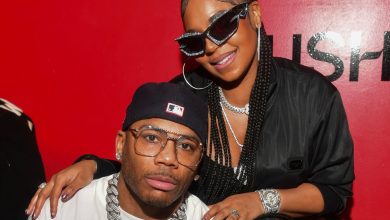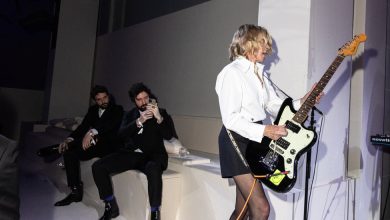Willie Nelson’s Sense of Style

“Roll me up and smoke me when I die,” Willie Nelson sang from the stage of the Hollywood Bowl during his 90th birthday celebration in April.
As usual, Mr. Nelson looked very much at ease. He was wearing a cowboy hat over a red bandanna, and his hair spilled down his back. His trusty guitar, a road-worn classical acoustic model named Trigger, hung from the red, white and blue strap around his neck. At his side was his longtime friend, the equally relaxed Snoop Dogg.
The duet with Snoop was one of many high points for Mr. Nelson in 2023, when fans and colleagues expressed their appreciation for one of the great survivors of American cultural life. In February, he won the Grammy for best country album. Two months later, he was joined by Beck, Rosanne Cash, the Chicks, Gary Clark Jr., Sheryl Crow, Keith Richards and other artists for the two-night Hollywood Bowl concert.
In November, shortly after his latest book, “Energy Follows Thought: The Stories Behind My Songs,” appeared in indie bookstores and Wal-Marts alike, Mr. Nelson was inducted into the Rock & Roll Hall of Fame. This month, CBS broadcast the Hollywood Bowl concert; and a four-part documentary retrospective, “Willie Nelson & Family,” started streaming on Paramount+.
But there was a time when Mr. Nelson’s prospects seemed shaky at best, when he was just one of many Nashville strivers who was trying to follow a path mapped out by music executives who supposedly knew better.
The turnaround came when he made a break from all that and decided to be fully himself, not only in his musical approach but in how he presented himself to the world.

Mr. Nelson, with Sheryl Crow, performed under a portrait of his former self at the Hollywood Bowl in April, during his star-studded 90th birthday celebration.Credit…Eduardo Munoz/Reuters
The Willie Nelson who appeared on the covers of the albums he made for RCA Records in the 1960s would seem to have almost nothing in common with the “cosmic cowboy” (as he once described himself) that audiences would come to know and love.
On the cover of his 1962 debut album “ … And Then I Wrote,” he is a short-haired fellow wearing a suit and an anxious grin. For his eighth studio album, “Good Times,” released in 1968, he hit a fashion low, posing in golf attire on a putting green while draping himself around a young woman in a miniskirt. The albums sold poorly, and Mr. Nelson grew more and more frustrated by his lack of agency.
In addition to foisting upon this sui generis singer-songwriter the image of a generic country star, RCA insisted that he use top-flight session musicians in the recording studio, rather than the down-home band that backed him on the road. It seemed that the label was doing everything to make Mr. Nelson a star but allowing him to be himself.
His transformation began in earnest after his farmhouse outside Nashville burned to the ground in 1969. As Kinky Friedman noted in the foreword to Mr. Nelson’s 2012 book, “Roll Me Up and Smoke Me When I Die,” the down-on-his-luck singer launched into his next phase by channeling the spirit of an earlier American iconoclast.
“Willie told the Nashville establishment the same words Davy Crockett had told the Tennessee political establishment: ‘Y’all can go to hell — I’m going to Texas,’” Mr. Friedman wrote.
In 1972 he settled in Austin, a city known for its progressive politics, laid-back vibe and mix of musical styles, from conjunto to the blues. He grew out his hair, started wearing bluejeans and T-shirts to perform at clubs like the Armadillo World Headquarters and doubled down on his switch from alcohol to pot as his preferred mood enhancer.
To keep the sweat out of his eyes, he wore a red bandanna around his forehead. He grew mutton chops, then a scruffy beard. The new look fit the changing times, though it wasn’t a calculated appeal to the counterculture.
“It felt good to let my hair grow,” Mr. Nelson reflected in his 2015 autobiography, “It’s a Long Story.” “Felt good to get onstage wearing the same jeans I’d been wearing all damn day. As I look at it, I was turning exactly into the person I was.”
He also managed to bridge a great divide in American cultural life. As Turk Pipkin, a writer and filmmaker who has coauthored two books with Mr. Nelson, put it: “He united the hippies and the rednecks.”
In 1973, he hosted the first of what would become an annual event, Willie Nelson’s Fourth of July Picnic. The concert, on a ranch in the Texas Hill Country, attracted dyed-in-the-wool country music fans as well as young progressives who were discovering his music through albums like “Shotgun Willie,” released that June on his new label, Atlantic Records.
Mr. Nelson’s willingness to follow his instincts was a key to his crossover success, said Peter Blackstock, who frequently covered Mr. Nelson for The Austin American-Statesman.
“Cowboys like Willie because he came from a country background and was born and raised in Texas,” Mr. Blackstock said. “What was unusual is that all these people who were listening to Led Zeppelin or Frank Zappa also got interested in Willie. They appreciated the individual streak there.”
Though he was considered part of the so-called outlaw country movement, Mr. Nelson couldn’t have chosen a more patriotic day to assemble his flock for a picnic; and his set list in those years, as today, included “Will the Circle Be Unbroken,” “Family Bible” and other songs that reflected his upbringing in the Baptist Church.
By 1978, Mr. Nelson was wearing his hair in long braids — a radical act for a male country singer. Even his fellow male “outlaws” Waylon Jennings, Kris Kristofferson and Tompall Glaser adhered to gender norms in their appearances.
In 1979, he showed up at the White House wearing jeans and a satin jacket to present a Country Music Association award to President Jimmy Carter. That night, Willie smoked what he called “a fat Austin torpedo” on the White House roof.
Much has been made of Mr. Nelson’s appreciation of marijuana and advocacy on its behalf. A 1978 profile in High Times magazine began, “Willie Nelson smokes a lot of dope.” In the 1990s, he joined the advisory board of the National Organization for the Reform of Marijuana Laws, or NORML.
Despite the waist-length hair and frequent pot-smoking, Mr. Nelson never abandoned his heartland roots. The High Times article quoted a friend who said he drove “a pickup truck with a gun rack”; and Mr. Nelson would go on to be a founder of Farm Aid, the annual benefit concert that has raised millions for American family farmers over the last four decades.
As the nation grew more divided, he still had a knack for bringing together opposing camps. In 2015, he stood on a stage in Washington, D.C., to accept the Library of Congress Gershwin Prize for Popular Song. Applauding him from a few feet away were Representative Kevin McCarthy, Republican of California, and Representative Nancy Pelosi, Democrat of California. In its report on the event, The Texas Tribune called Mr. Nelson “the only person who can bring Democrats and Republicans together in the nation’s capital.”
Contradictions have defined his life and career. Mr. Nelson is someone who owns a home in Maui, Hawaii, with views of the Pacific Ocean, yet for several years also operated Willie’s Place, a truck stop and biodiesel processing plant in Carl’s Corner, Texas. He has taught Sunday school in Fort Worth, Texas, and praised Las Vegas for its “hustler energy.” He has had his assets seized by the I.R.S. and sung with President Obama at a 2014 benefit concert for veterans.
“The common thinking for almost all of us is to see things as contrary positions, and we all fall into it,” Mr. Pipkin said. “Willie doesn’t necessarily see them as contrary. He doesn’t see the billionaire and the bum in different ways.”
Or, as Mr. Nelson put it in his autobiography, “I’m a man of many parts.”



